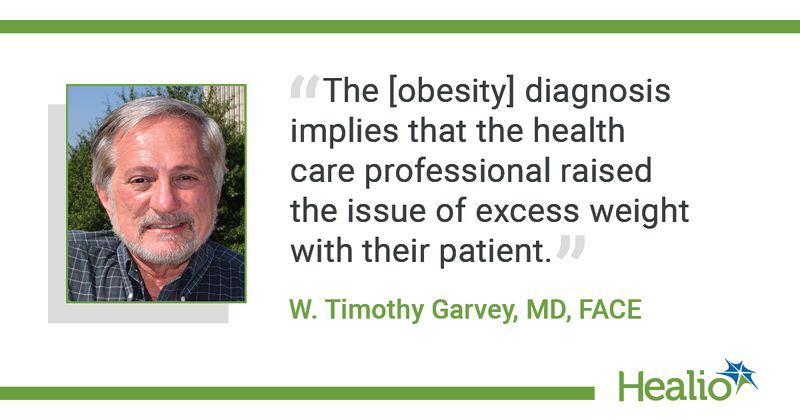Documented obesity diagnosis independent predictor of weight loss
A formal diagnosis of obesity on the same day as an initial recorded weight is independently associated with weight loss 9 to 15 months later, according to a large analysis of electronic health care records.
“In a large sample of patients drawn from the electronic medical records of 15 diverse health care systems, just the recorded diagnosis of obesity is associated with greater weight loss and the likelihood of losing at least 5% weight loss, compared with patients with high BMI who do not have the diagnosis,” W. Timothy Garvey, MD, FACE, professor of medicine at the University of Alabama at Birmingham, told Healio. “This is independent of demographics, insurance, obesity medications and other factors.”

In an observational study, Garvey and colleagues analyzed the relationship between weight loss and documentation of an obesity diagnosis, examining EHR data from 688,878 adults with a BMI of at least 30 kg/m² from 15 health systems. Researchers used logistic regression models using a stepwise backward elimination procedure to identify potential predictors of weight loss.
Within the cohort, 44.9% of patients had an obesity diagnosis on a claim or EHR problem list, whereas 16.9% lost at least 5% of body weight and 5.9% lost at least 10% of body weight.
“Regrettably, the overall rate for documentation of obesity as a disease remains low,” the researchers wrote.
Researchers found that a diagnosis of obesity on the same day as the initial weight was a predictor of 5% weight loss in 9 to 15 months, with an OR of 1.3 (95% CI, 1.2-1.3). Other significant predictors included an obesity medication prescription, female sex, diagnosis of type 2 diabetes, having Medicare or Medicaid insurance, and number of ambulatory visits.
“Primary care professionals are first-line in the delivery of health care and need to be aware of obesity as a disease and to diagnose the disease when present,” Garvey said. “This alone is associated with improved health in their patients. Perhaps there are two reasons: The diagnosis implies that the health care professional raised the issue of excess weight with their patient and how it might be affecting their health, and having the recorded diagnosis would predispose to the development of a therapeutic plan.”
Garvey said it was noteworthy that a prescription for obesity medication on the day of diagnosis was associated with the highest likelihood of losing more than 5% (OR = 2.2; 95% CI, 2-2.4) and 10% of body weight (OR = 2.3; 95% CI, 2-2.7).
“We must learn how we can better target the tools of obesity medicine to lessen the suffering and social costs of obesity in a manner that optimizes benefit-risk ratio and cost-effectiveness, based on risk assessment and disease severity,” Garvey said.
For more information:
W. Timothy Garvey, MD, FACE, can be reached at garveyt@uab.edu.

